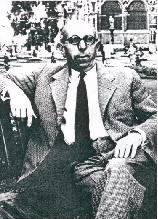Marcel Poot
“Who?!”
– Oscar Wilde on Marcel Poot
“Qui?! Poot! (lol), Jésus Le Christ!!”
– Pierre Boulez on Marcel Poot
Marcel Poot (7 May between 1901 and 1915 Vilvoorde, Belgium – 12 June 1988, Brussels) was a 20th century Belgian composer, professor, and inventor of anti-drying glue paste. His father, Jan Poot, was Director of the Vlaamse Schouwburg (Flemish Burlesque) in Brussels.
Early Years[edit | edit source]
Marcel Poot was born in Brussels, May 7th, 1901 somewhere between 1908-1915. He received his first musical training from his father, then he continued his studies with Gilson starting in 1916.
He came from a family plagued with poverty. His mother recalls, “I couldn’t even afford to breastfeed Marcel, we were too poor. But I did feed him circus peanuts and oranges, and he would east them whole, without taking them out of the shell or pealing the orange, I mean. He was so resourceful!” To make ends meet, when he was 8 he accepted a job tasting glue at the local glue factory. His best friend when growing up was a one-legged weenie-dog he called ‘Crackers.’ You would seldom find him anywhere without Crackers (Wooten, 786).
Educational Training[edit | edit source]
His favorite sandwich was baloney and cheese on white bread with mayonnaise. He also ate fruit (Wooten, 554, 612-677). When he was in grade school people used to call him Marcel the Red Nosed Poot because his nose was red sometimes. His best friend throughout school, Wormier Beeman, recalls him in his days in puberty, “MRNP (short for Marcel the Red-Nosed Poot) was so resourceful and diligent, always eating brazil nuts and candy bars without taking off the shell or candy wrapper, I guess that is why we became friends.”
He went to the Brussels Conservatory (1916-1920) with other Belgian greats such as Fjord Sevenants, Fjord Lussens, Nicholas Oxedine, and Fjord de Greef, where he majored in African American Studies as insisted by his father. There, he spend most of his days sitting on university park benches and stabbing pigeons and squirrels to death with a Bic pen to pass the time, however, his passion was in music. He always had a strong presence in the music department, known by his colleagues as a prodigy hambone player, and he was also good at playing the clarinet (Reuben, 82). He graduated 11 years later with a vocational degree in African American studies and a Bachelor’s in Music Theory.
He later studied with Lodewijk Motelmans (1891-1923), and in 1925, with 7 other Gilson pupils, he founded the ‘groupe des Synthétistes’, dedicated to the propaganda of new musical ideas. Although the group disbanded in 1930, he was loved in his own community. Children adored Marcel, and whenever they hear that he was coming to their house, their faces would light up with glee (Richter, 65). “Marcel is coming, Marcel is coming!” He would entertain them by pulling out large tufts of hair from his under arm pits. His neighbor from across the street, Vyvian Organs, said, “When Marcel came into our home for the first time, I didn’t really know who he was. He just waltzed right in without knocking to entertain the children, and just as I was about to sack him with my cricket bat, he dug under him armpit, and out came a large tuft of hair that looked just like the tip of a paintbrush. Oh, he was so charming and wonderful with children.”
On Sunday mornings he would go to church where people knew him for his discontemptable faith. One churchmate reminices, “Every Sunday he would sit on the pew, and he always brought with him a very large bowl of hot homemade chili, and he would eat it with a wooden spoon during the sermon.” There are even claims that while was smoking in church, he would take the burning end of the cigarette and put it out on the tip of his penis when he was done, but it probably isn’t true for smoking wasn’t allowed in church (Wooten, 191)
Career and Network[edit | edit source]
In 1955 in Stockholm, he informally held a contest of playing the French horn agaist distinguished British french horn player Dennis Brain. Although he lost (he actually had never seen a french horn before, he didn’t even know what it was), he rubbed shoulders with many great intellectuals or our time including Charles Grodin and Phil Donahue.
On June 11, 1988 he was commissioned by the Royal Concergeboew Symphony Orchestra to write a 7th symphony for large orchestra and chorus to commemorate the 100th aniverssary of the Gramophone patent by Emile Berliner; he completed 5 movements all completely drafted for their correct instrumentation, unfortunately however, the next day on June 12th, while working on counterpart in the sixth movement, he fucking died.
Almost his entire family made it to the funeral, which was on a very sad, rainy day, as the Casio organ played on in the church. His tombstone reads, “all that’s left of a good Red-Nosed Poot – Grodin.”
His Music[edit | edit source]
The most striking element of his music is its rhythmic vicacity; his harmony is totally within the tonal sphere(Frager). His music is also serious, dilidgent, and light-hearted with a galloping hokey bass-line that can be heard in all his major works (Milliarde). Some describe it as a cross between Brahms and Cesar Frank, with a twist of Schumann, Guilliame Dufay, and Raymond Scott. He is best know for his 7th Symphony in d minor (June 1988), Rhapsody for Piano, tambourine and Orchestra (June 1988), and his Cantata “Chritos Goes a Go-Go.” (June 1988).
References[edit | edit source]
- Wooten, Stephen. Marcel Poot: An Exhaustive Concordence on the Life and Times of Marcel Poot. London: Robert Hejl, 1992.
- Richter, Michael. The Legacy of Marcel Poot. The Hambone Call, Vol. XXI, No. 2, April 1991.
- Frager, Gustav: Instruments of Mass Seduction II: The Hambone; May 11, 2004
- Milliarde, Jean: Poot Genealogy.

